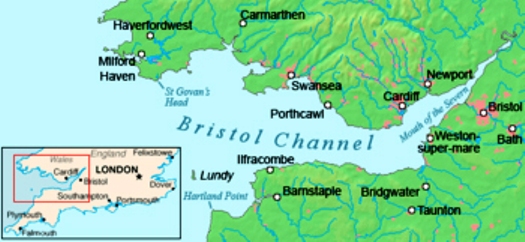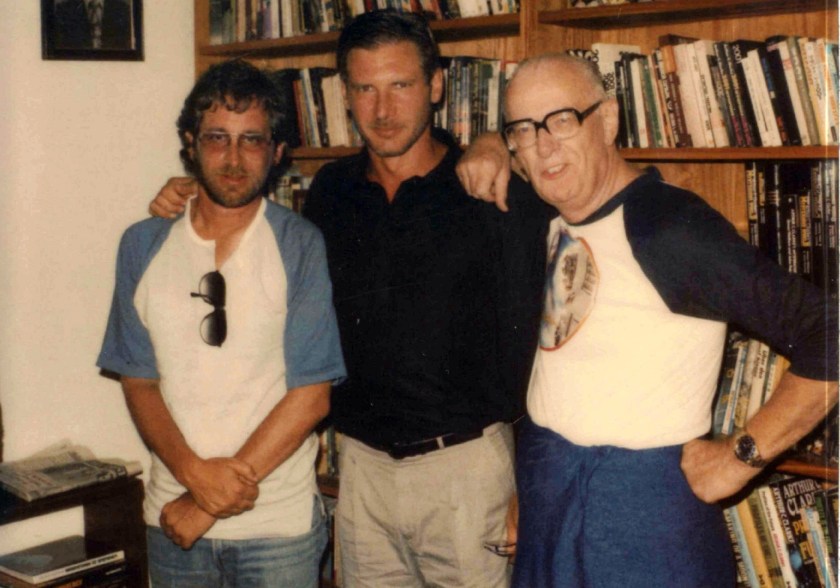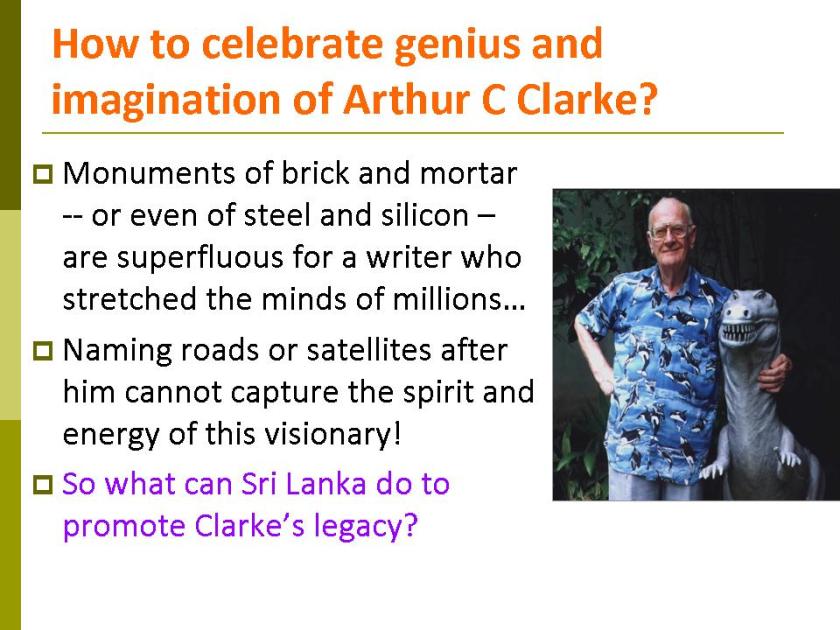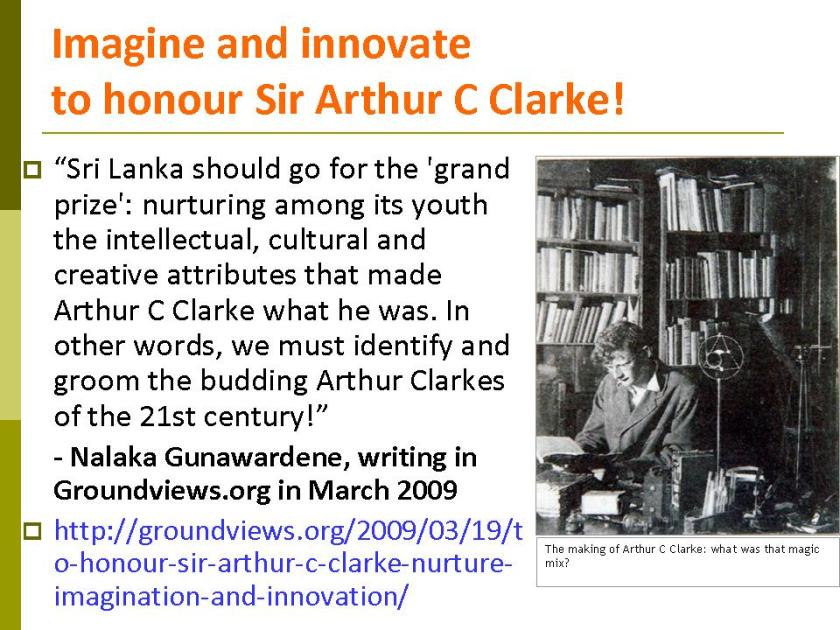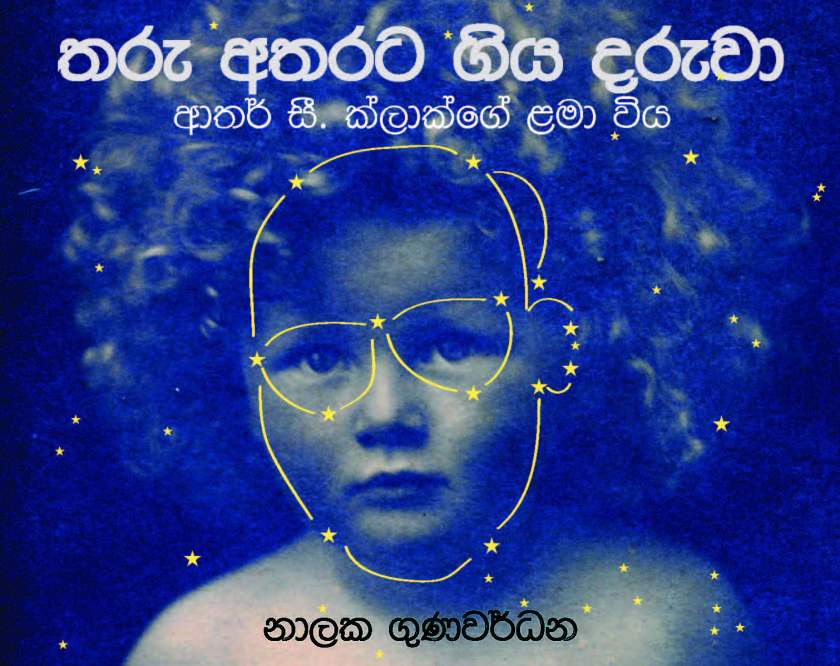In this week’s Ravaya column, (in Sinhala, appearing in issue of 20 Sep 2015), I share some excerpts from my recent book on the childhood of Sir Arthur C Clarke (1917 – 2008), author, undersea explorer and futurist.
Titled ‘Tharu Atharata Giya Daruwa: Childhood of Arthur C Clarke’, the book is written in story-telling style in conversational Sinhala. It is suitable for readers of all ages, and especially for parents, teachers and children.
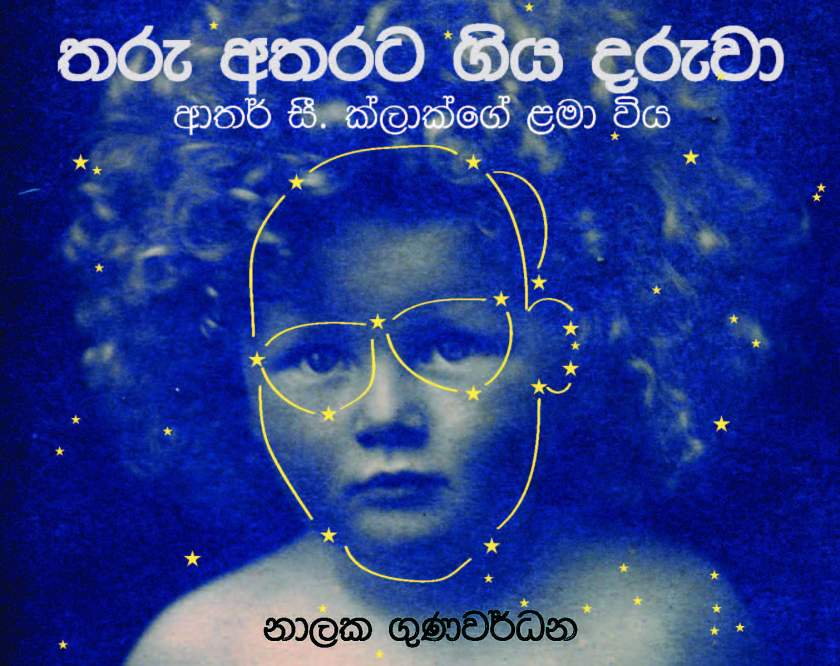
Clarke’s accomplishments are known much more than his humble origins and early inspirations in life. He was born in rural England as the First World War was ending, and spent his childhood years in Minehead, Somerset, close to the sea.
Arthur was the eldest in a family of four, who were raised by their dynamic mother, widowed at a young age. Despite cycling 20 km to school and back and helping on the farm, he excelled in studies and pursued serious hobbies – star gazing, mechanical experiments and nature observations.
His experiences were shaped largely by growing up on the family farm, exploring the local beach, and working part-time at the village post office. Early on, he cultivated habits like good time management, thrift, careful storage of everything and multi-tasking – all of which lasted a lifetime. He knew the value and limits of money, respected the dignity of labour, and appreciated honesty and hard work in everyone.
The book is widely illustrated with 74 photographs including many drawn from family albums preserved by the Arthur C Clarke Trust that now manages the Clarke Literary Estate. It also carries some original caricatures drawn by cartoonist and artist Dharshana Karunathilake who designed the book.
See also: ආතර් සී. ක්ලාක් සහ ශ්රී ලංකාව: නිවැරදි තොරතුරු මෙන්න!
Images courtesy Arthur C Clarke Trust, Sri Lanka

ලෝක පූජිත විද්යා ලේඛක හා අනාගතවේදී ආතර් සී. ක්ලාක්ගේ ළමා කාලය ගැන අප්රකට හා රසවත් තොරතුරු කැටි කර ගත් පොතක් මා මෑතදී රචනා කළා.
‘තරු අතරට ගිය දරුවා’ නම් පිටු 120ක මේ පොත ලිවීමට මා ක්ලාක්ගේ පර්යේෂණ සහායක ලෙස වසර 21ක් ක්රියා කිරීමෙන් ලත් අත්දැකීම් මෙන්ම ක්ලාක්ගේ පවුලේ අය මුණ ගැසී දැන ගත් තොරතුරු හා ඔහුගේ උපන් ගමට ගිය චාරිකාවක තොරතුරු ද යොදා ගෙන තිබෙනවා.
ශ්රී ලංකාවට මහත් සේ ඇලූම් කළ ක්ලාක් ගැන බොහෝ ලාංකිකයන් හරිහැටි දන්නේ නැහැ. මේ පොතින් මා උත්සාහ කරන්නේ අද කාලයේ ළමුන්, දෙමව්පියන් හා ගුරුවරුන්ට ඔහුගේ ළමා කාලයෙන් ගත හැකි ආදර්ශ හුවා දැක්වීමටයි. අද බෙදා ගන්නේ පොතේ අන්තර්ගතයෙන් ටිකක්.
හැම විශිෂ්ඨ චරිතයක් ම පන්නරය ලබන්නේ තමන්ට ආවේණික වූ පසුබිම හා අභියෝග හරහායි. විශිෂ්ඨයන්ගේ ලාබාල කාලය හා ඔවුන් දුක දිනා ජය ගත් සැටි සැම කල්හි සැම තැනම දිරියවන්තයන්ට ප්රබෝධක ආවේගයක් ලබා දිය හැකියි.
එසේ ම පරිකල්පනය හා නිර්මාණශීලි බව දරුවන් තුළ උද්දීපනය කරන්නේ කෙසේදැයි දෙමවුපියන්ට හා ගුරුවරුන්ට ගත හැකි ආදර්ශයන් හා ගුරුහරුකම් රැසක් ද ක්ලාක් චරිතයෙ තිබෙනවා.
ආතර් චාල්ස් ක්ලාක් දරුවා උපන්නේ 1917 දෙසැම්බර් 16 වනදා එංගලන්තයේ සමර්සෙට් ප්රාන්තයේ මයින්හෙඞ් ගම්මානයේ (Minehead). ඔහුගේ පියා චාල්ස් රයිට් ක්ලාක් හා සීයා තෝමස් ක්ලාක් දෙපල ම තැපැල් සේවයේ නිරත වූ අයයි. මව නෝරා විලිස් ක්ලාක්.
කලක් තිස්සේ බිෂොප්ස් ලිඩියාඞ් (Bishops Lydeard) නම් අල්ලපු ගමේ තැපැල් ස්ථානාධිපති වූයේ මේ ක්ලාක් පවුලේ උදවියයි. ඔවුන් බොහොම සාමාන්ය මට්ටමේ ග්රාමීය පවුලක්.
1914-18 කාලයේ යුරෝපය දෙවනත් කළ පළමුවන ලෝක යුද්ධයට පියා චාල්ස් රයිට් ක්ලාක් ද අනිවාර්ය හමුදා සේවය යටතේ බඳවා ගනු ලැබුවා. හමුදා සේවයේදී ප්රංශයට යවනු ලදුව යුධ බිමේදී විෂ වායු ප්රහාරයකට හසු වී තුවාල ලැබූ ඔහු ඉනික්බිති පෙනහළු ආබාධිත තත්ත්වයේ පසු වුණා.
යුද්ධයෙන් පසු ගමට ආ ඔහු තැපැල් කන්තෝරුව වෙනුවට ගොවිපලක් කිරීමට තීරණ කළා. හමුදා සේවයේ සිට නැවත සිවිල් ජීවිතවලට යොමු වන තරුණ තරුණියන්ට එරට රජයෙන් ලබා දුන් මුදල් ආධාර යොදා ගෙන ඔහු බැලිෆන්ට්ස් (Ballifants) නම් ගොවිපලක් මිළට ගත්තා. ආතර් ක්ලාක් දරුවා ලොකු මහත් වූයේ ගමෙන් කිලෝමීටරයක් තරම් දුරින් පිහිටි මේ කුඩා ගොවිපලේයි.

නෝරා හා චාල්ස් දෙපලගෙන් එක් අයකුටවත් ගොවිපලක් කිරීමේ පුහුණුව හෝ අත්දැකීම් තිබුණේ නැහැ. එහෙත් අළුත් දෙයක් කිරීමේ අදිටනින් හා උද්යොගයෙන් ඔවුන් එයට යොමු වුණා. එය එතරම් සාර්ථක නොවුවත් ප්රවේශමින් කටයුතු කිරීම හරහා පවුලේ වියදම් පියවා ගන්නට ඔවුන්ට හැකි වුණා. එසේම තමන්ම හදා ගත් අළුත් ආහාරපාන දරුවන්ට දීමට අවස්ථාව ලැබුණා.
පවුලේ වැඩිමහලූ දරුවා වූ ආතර්ට පසුව තවත් සහෝදරයන් දෙදෙනකු සහ සහෝදරියක උපන්නා. පියා යුධ ආබාධිත වූ බැවින් මේ දරුවන් හදා වඩා ගත්තේ මවයි. ඉමහත් දිරියක් හා වැඩ කිරීමේ හැකියාවක් තිබූ කාන්තාවක් වූ ඇය දරුවන්ට අවශ්ය මග පෙන්වීමත්, නිදහසත් ලබා දුන්නා.
බැලිෆන්ට්ස් ගොවිපල අක්කර කිහිපයක බිමක් වසා ගත් කුඩා පරිමානයේ ගොවිපලක්. නෝරා හා ඇගේ දරුවන් වෙහෙස වී වැඩ කිරීම හරහා එය නඩත්තු කළා. ශ්රමිකයන් ගෙන්වා ගත්තේ තමන්ට කළ නොහැකි බර වැඩට පමණයි.
එළදෙනුන්ගෙන් කිරි දෙවීම, කිකිළි බිත්තර එකතු කිරීම, කාලයෙන් කාලයට බැටලූ ලොම් කැපීම හා දිනපතාම සතුන්ට කෑම දැමීම හා ඔවුන්ගේ මඩු පවිත්ර කිරිම වැනි කාරියන් රැසක් ක්ලාක් දරුවන්ට පැවරුණා. ඔවුන් පාසල් ගියේ උදෙන් අවදි වී පැයක් දෙකක් පමණ ගොවිපලේ වැඩ කිරීමෙන් පසුවයි.
හිරුට කලින් පිබිදීම, කඩිසරව හා උද්යොගයෙන් වැඩ කිරීම, කරන හැම දෙයක්ම පිළිවෙලට කිරීම හා කිසි විටෙක අලස නොවීම වැනි චරිත ගති ආතර් ක්ලාක් දරුවා උගත්තේ කුඩා කාලයේ ගොවිපලේදී. මේ ගතිගුණ ඔහුගේ ජීවිත කාලය පුරා පවත්වා ගත්තා.

අගහිඟකම් මැද වුවත් ආත්ම ගෞරවය රැක ගෙන, අභිමානයෙන් යුතුව ජීවත් වීමේ වටිනාකම ක්ලාක් දරුවන් කුඩා වියේදීම වටහා ගත්තා. ඉවත දමන එදිනෙදා ද්රව්යවලින් අතුරු ප්රයෝජන ගැනීම, සකසුරුවම් බව හා නාස්තිය වැළැක්වීම වැනි ගුණාංග, ආතර් සී. ක්ලාක් ලේඛකයාගේ ජීවිතය පුරා දැකිය හැකි වුණා. කඩදාසියක දෙපැත්තම භාවිත කිරීම, ලියුම් කවරයක් දෙතුන් වරක් පාවිච්චිය වැනි පුරුදු මා උගත්තේ ඔහු සමග වැඩ කිරීමෙන්.
බැලිෆන්ට්ස් ගොවිපලේ 1920 දශකය ගෙවී ගියේ විදුලි බලය නොමැතිවයි. දරුවන් ලාම්පු එළියෙන් පාඩම් කළා. එකල ටෙලිවිෂන් මාධ්යය ඇරැඹී තිබුනේ නැහැ. මේ නිසා දැනුම හා විනෝදය එක් තැන් කරන ගෘහස්ත ක්රීඩා තමන් ම හදා ගන්නට නෝරා මාතාව ක්රියා කළා.
සීත සෘතුවේ රාත්රී කාලය පැය 15-16ක් දක්වා දිගු වනවා. මේ දිගු සන්ධ්යාවන් ගත කරන්නට දරුවෝ නොයෙක් ලෑලි කී්රඩා (board games) කළා. ඒත් ටික දිනකින් ඔවුන්ට ඒවා එපා වුණා. නිතර නිතර අළුත් ක්රීඩා නිර්මාණය කරන්න නෝරාට සිදු වුණා.
ඇය දරුවන් සමග කළ එක් ජනප්රිය ක්රීඩාවක් වූයේ ගණිත විනෝදයයි. කැල්කියුලේටර් නොතිබි ඒ යුගයේ ඉක්මනින් ගණනය කිරීම් කරන්නට තිබුණේ ස්ලයිඞ් රූල (slide rule) නම් උපකරණයක් හා ලඝුගණක පොත් පමණයි.
වැඩි කිරීම, බෙදීම, එකතු කිරීම හා අඩු කිරීම අවශ්ය වන සංකීර්ණ ගණිත ගැටළු නෝරා සිය දරුවන්ට දෙනවා. බොහෝ විට මුලින්ම උත්තරය හදා ගන්නේ ස්ලයිඞ් රූල පාවිච්චි කළ ආතර්. අන්තිමේදී කිසිදු උපකරණයක් නැතිව ගණිතමය ක්රම මගින් පමණක් උත්තරය සොයා ගන්නා නෝරා, සිය දරුවන් දෙදෙනාගේ උත්තර සමග එය සසඳා බලනවා.
‘‘අප නිතර මේ ගණිත ක්රීඩා කළා. සන්ධ්යාව අවසානයේ අප දිනුවත් පැරදුණත් අම්මා අපට රසකැවිලි දෙනවා. එහෙත් සැබෑ ත්යාගය වූණේ පාසලේ වාර විභාගයේදී ඉක්මනින් හා නිවැරදිව ගණන් හැදීමට පුළුවන් වීමයි. ජීවිත කාලය පුරාම ගණිතයට බය නොවී වැඩ කරන්නට අපට හැකි වුණා’’ ආතර් පසු කලෙක ලියා තැබුවා.

ගොවිපලේත් ඒ ගමේ ම වඩාත් මුහුදට සමීපව පිහිටි මිත්තනියගේ ගෙදරත් ආතර් කල් ගත කළා. කුඩා කාලයේ පටන් ඔහු සාගරයටත්, අහසටත් ඇලූම් කළා. මේ දෙක පසු කලෙක ඔහුගේ වෘත්තිය ජීවිතය මහත් සේ සමීප වූවා.
ආතර් සමාජශීලි හා මිත්රශීලි චරිතයක් වුවත් තමන්ගේ ම සිහින ලෝකයක තනි වීමේ නැඹුරුවක් ද කුඩා කල පටන් ඔහුට තිබුණා. මුහුදු වෙරළේත්, ගොවිපලේත්, ඇතැම් විට පන්ති කාරමයේත් ඔහු දවල් හීන බැලූවා. වාසනාවකට ඔහුගේ වැඩිහිටියෝ එයට එරෙහි නොවී මේ දරුවාට සිහින මවන්නට ඉඩ දුන්නා.
කුඩා ආතර් රාත්රී අහස ගැනත් දැඩි කුතුහලයක් හා උනන්දුවක් දැක් වූවා. සරල දුරදක්නයක් වුව මිළදී ගන්නට තරම් වත්කමක් තිබුණේ නැහැ. තමන්ගේ දුරදක්නයක් සාදා ගත් පසු මේ ප්රශ්නය විසඳුනා. ඔහු අහස නිරීක්ෂණ කළේ පාසල් වැඩ කටයුතු හා ගොවිපලේ වැඩට තමන්ගේ දායකත්වය අතපසු නොකරයි.
ප්රාථමික පන්ති සඳහා ගමේ පාසලට ගිය ඔහු ද්විතියික මට්ටමට අසල ටෝන්ටන් (Taunton) නගරයේ හුයිෂ්ස් ග්රැමර් ස්කූල් (Huish’s Grammar School) නම් පාසලට ඇතුළු වුණා. ගෙදර සිට පාසලට දුර සැතපුම් හයක් (කිමි 10ක්) පමණ ඇති. උදයේ මේ දුර බයිසිකලයෙන් ගිය ආතර් යළිත් සවසට බයිසිකලයෙන් ම ගෙදර ආවා.
දවසකට කිමි විස්සක් සයිකල් පැදීම නිසා වෙනත් ව්යායාම අවශ්ය වුයේ නැහැ. ඉතා දුෂ්කර දිනයක හැරෙන්නට සීත සෘතුවේ දැඩි කාලගුණ තත්ත්වයන් යටතේත් ක්ලාක් දරුවන් බයිසිකලෙන් පාසල් ගියා.
ආතර් පාසල් කාලයේදී කණ්ඩායම් ක්රීඩාවලට උනන්දු වූයේ නැහැ. පිහිනීමේ හැකියාව තිබුණත් තරගකාරී පිහිනුමට ගියේ ද නැහැ. ගොවිපලකින් පාසලට ආ ළමයකු ලෙස ඇතැම් සිසුන්ගේ උසුළු විසුළුවලට ඔහු ලක් වීම මෙයට හේතු වුවා විය හැකියි.
ගොවිපලේ වැඩවලට උදව් වී පාසල් යන ක්ලාක් දරුවන් ‘ගොම ගඳයි’ කියා හෑල්ලූ කිරීමට සමහර ප්රභූ දරුවන් පුරුදුව සිටියාලූ. ආතර් හා ඔහුගේ සොයුරු සොයුරියන් මෙයින් කම්පා වුයේ නැහැ.
ආතර් වයස 13දී ඔවුන්ගේ රෝගාතුර පියා මිය ගියා. ඒ 1931 මැයි මාසයේදී. එතැන් පටන් පවුල නඩත්තු කිරීමේ මුළු බර ම කරට ගත්තේ මව නෝරායි. නව යොවුන් වියේ පසු වූ ආතර් ගොවිපලේ වැඩට කැමැත්තෙන් ම ඉදිරිපත් වුණා. එසේ ම පියාගේ වියෝවෙන් පසුව පවුලේ වැඩිමහලූ පිරිමියා ලෙස වගකීම් දැරුවා.
ඒ සියල්ල හා පාසලූ වැඩ කරන අතර රාත්රී අහස නිරික්සීමත් විවිධ විද්යාත්මක අත්හදා බැලීම් කිරීමත්, පොත් කියවීමත් ඔහු නිතර කළා. කාලය කළමණාකරණය කිරීම ඔහු කුඩා කාලයේ පටන් ප්රගුණ කළා.
ආතර්ගේ විද්යා අත්හදා බැලීම් යොමු වුණේ රසායන හා භෞතික විද්යාවන් පැත්තටයි. එදිනෙදා ද්රව්ය යොදා ගෙන මල්වෙඩි නිපද වූ ඔහු ඉන් පසු කුඩා රොකට් තනා අහසට යැවීමට තැත් කළා. රොකට්වලට අමතරව සන්නිවේදන උපකරණ සමග විවිධ අත්හදා බැලීම් කරන්නටත් ආතර් බොහෝ උන්නදු වුණා.
කුඩා වියේ පටන් විද්යාත්මක පොතපත හා විද්යා ප්රබන්ධ ගැන ආතර් උනන්දු වුණා. පෙළ පොත්වලට අමතරව පාසල් පුස්තකාලයේ තිබූ බොහෝ පොත් ඔහු මහත් ඕනෑකමින් කිය වූවා. ඊට පසු ටවුමේ මහජන පුස්තකාලයේ පොත්පත් සොයා ගෙන කිය වූවා. බාල වියේදී තමා දිනකට පොතක් බැගින් කියවා හමාර කළ බව ඔහු ලියා තිබෙනවා.
ටෝන්ටන් ටවුමේ පිහිටි පොත් සාප්පුව ආතර්ගේ ප්රියතම ස්ථානයක් වුණා. අදට වඩා අඩු වුවත් එවකට පොත් මිළ ගණන් පවා මේ ගොවිපළ දරුවාට දරා ගත නොහැකි වුණා. එහෙත් එම බාධකය ජය ගන්නට උපක්රම දෙකක් ඔහු සොයා ගත්තා.
එකක් නම් පොත් සාප්පුවට දිනපතා ගොස් තමන්ට රිසි පොත් කඩින්කඩ සාප්පුවේදීම කියැවීම. ටික දිනකින් හිමිකරුවා මෙය තේරුම් ගත්ත ද එයට බාධා කළේ නැහැ.
දෙවැන්න නම් කියවා නැවත විකිණීමට ඇති (second-hand) පොත් හා සඟරා අඩු මිලට ගැනීම. පාසල් විවේකයේදී යමක් කෑමට බීමට අම්මා අතට දෙන මුදල් වැඩි හරියක් ඉතිරි කර ගෙන ඔහු මේ සඳහා යොදා ගත්තා.
පසු කලෙක ලෝකයේ පිටපත් මිලියන ගණන් අලෙවි වූ පොත් ලියූ ලේඛකයා කුඩා කාලයේ පොත් කියවූයේ මෙලෙස උපක්රමශීලිව හා සකසුරුවමින්.
තමන්ගේ නිර්ප්රභූ, ගැමි ආරම්භය ගැන ඔහු කිසි විටෙකත් කරුණු සැඟවූයේ නැහැ. පසු කලෙක ඔහු පසු කලෙක තමන් හඳුන්වා දුන්නේ ස්වෝත්සාහයෙන් හා පරිකල්පනයේ පිහිටෙන් ලොවේ නමක් දිනූ කෙනෙකු හැටියටයි.
පොදුවේ ගත් විට ආතර් සී. ක්ලාක්ගේ පාසල් කාලය සතුටින් හා නිර්මාණශීලිව ගත වූවා. අන් අය තමා ගැන කියන දේ නොතකා තමන්ගේ පාඩුවේ වැඩ කර ගෙන යාමේ පුරුද්ද ඔහු කුඩා කාලයේ ම ඇති කර ගත්තා. එසේ ම අධිෂ්ඨානය, දැඩි අවධානය හා ඉලක්කයන් හඹා යාමත් ඔහු බාල වියේදී ම ප්රගුණ කළා.
සුරත ප්රකාශනයක් වන ‘‘තරු අතරට ගිය දරුවා’’ පොත, කොළඹ ජාත්යන්තර පොත් ප්රදර්ශනයේදී වට්ටම් සහිතව ලබා ගත හැකියි. ආතර් සී. ක්ලාක් භාරය සතු ඓතිහාසිකව ඡායාරූප රාශියක් ද පොතෙහි තිබෙනවා. පිටු සැළසුම හා නිමාව කාටුන් හා චිත්ර ශිල්පී දර්ශන කරුණාතිලක විසින්.

